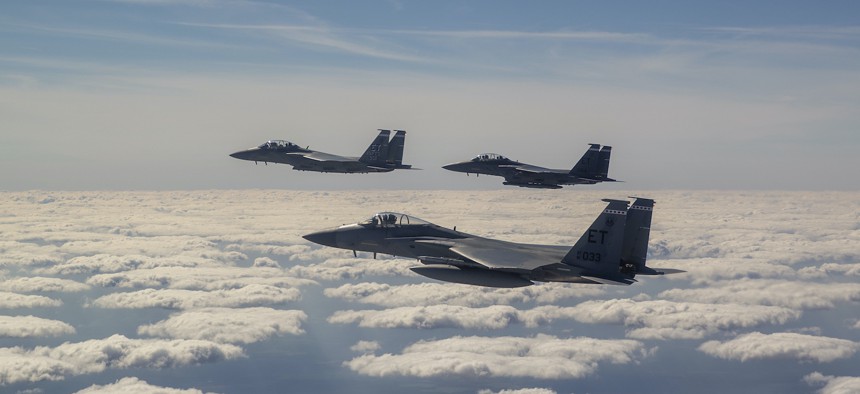
Lt. Col. Richard "Tac" Turner, Commander, 40th Flight Test Squadron, and Lt. Col. Jacob "Duke" Lindaman, Commander, 85th Test & Evaluation Squadron, deliver the first F-15EX to its new home station, Eglin AFB, Florida, 11 March, 2021. U.S. Air Force / Tech. Sgt. John Raven
Air Force Wishlist: Accelerate E-7 Production, Extend F-15EX Range, Buy New Radars for F-16s
The service’s “unfunded priorities” list also includes $1.2 billion for 21 military construction projects.
The U.S. Air Force wants $2.5 billion from Congress to speed up E-7 production, buy fuel tanks to extend the range of its F-15EX fleet, and purchase upgraded radars for its F-16s, according to an “unfunded list” of programs that didn’t make it into the service’s $185.1 billion 2024 spending request.
The service’s wishlist, obtained by Defense One, includes $633.4 million to accelerate the delivery of two E-7 Wedgetail aircraft. The money would cover long-lead items for the “green” 737 body—the aircraft itself without any modifications—and the E-7’s multirole electronically scanned array, or MESA, radar.
As the service works to field the first rapid-prototype E-7 in 2027, it also wants additional research and development funding to “reduce risk” in the schedule. Service officials have said they need E-7s in the Indo-Pacific region to meet the demand for airborne domain awareness and to maintain air superiority.
The Air Force wants to divest two E-3 Sentry AWACS-carrying radar planes in this year’s budget request—a move Congress blocked last year. Air Force Secretary Frank Kendall told reporters ahead of the budget rollout that the service wants to speed up E-7 production, but said “we’re not losing a lot” by retiring the E-3s before the E-7 arrives because the E-3 sensors are “pretty ancient” and the aircraft are expensive to maintain.
The service’s wishlist also includes $174.5 million to buy the Northrop Grumman-made active electronically scanned array APG-83 radar for the F-16 fleet.
With the radar, “over 25 percent” of the F-16 fleet can “execute homeland defense,” which would improve the military’s ability to protect its territory and assets, according to the document.
As the Pentagon focuses on countering China, the service also wants to extend the range of its F-15EX fighter jets in the Pacific, and is seeking $63.6 million to buy 12 “conformal fuel tanks.”
The fuel tanks would add 12 weapons stations and allow the aircraft to perform a “full range of air-to-air and air-to-ground missions,” the document said.
The biggest item on the service’s unfunded priorities list is $1.2 billion for 21 military construction projects—including funding for F-35 maintenance facilities, natural disaster recovery, and family housing.
Other items on the list include $227.8 million for agile communications equipment and $129.9 million for an “ISR digital infrastructure.”
The Space Force’s unfunded priorities list includes $477 million for seven projects—six of which are classified.
The only unclassified line item is $43 million to speed up the deployment of 16 “enclaves”— new segments of internal networks for the Space Force.
NEXT STORY: Army Wishlist: Tank Upgrades, Augmented Reality




